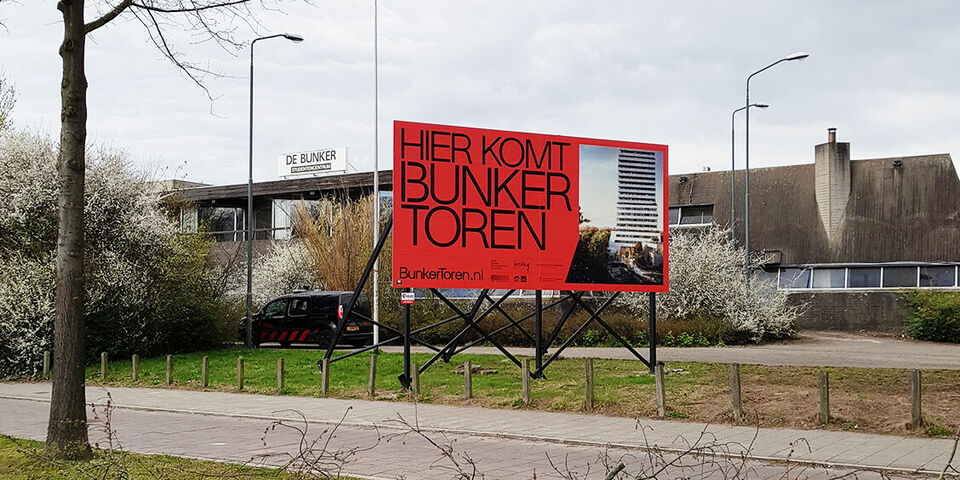TU/e officially sold the Bunker
TU/e sold the Bunker to Bunkertoren BV, the so-called special purpose vehicle of real estate company Being Development and architectural firm Power House Company, last Friday. The developer and a TU/e team worked on the transaction for three years. TU/e team member and Full professor at the Department of Architecture, Building and Planning Bernard Colenbrander is satisfied with agreements made on the preservation of this iconic building from architect Hugo Maaskant.
TU/e receives a handsome price for the sale of the Bunker, but none of the parties involved wish to divulge the exact figure. Bernard Colenbrander, full professor of Architectural history, is especially pleased with the agreements that were made concerning the preservation of the building made from rough concrete, which he describes as “Maaskant at his toughest.”
The block-like, geometrical, repetitive forms are typical characteristics of the architectural style known as Brutalism. The building was designed by Hugo Maaskant, who worked during the post-war reconstruction years and is most famous for the Euromast in Rotterdam. But, Colenbrander says, hardly any mention is made of the Bunker in any of the biographies and catalogues on this architect from Rotterdam.
“Entering into a discussion on this issue with architect Power House Company was quite a delicate matter, but as chairman of the Quality commission I was given the opportunity after mediation from Veronique Marks, who was director of Real Estate Management at the time,” Colenbrander says. “I had made a value assessment together with full professor Christian Rapp at an earlier stage, but we’re dealing with a commercial project here in which TU/e no longer plays a role. That’s entirely different from renovating a building on campus for a new usage, as was done successfully with Atlas.”
Characteristics
Colenbrander is pleased that the Bunker’s characteristic appearance remains intact, even though a 100 meters high residential tower will be built on top. “Only a quarter of the building, on the west side where the cafeteria was located, needs to be demolished for this purpose. The building may not be a monument, it is nevertheless of great historical value to the student associations that were located there. The university has a kind of moral obligation towards the building, and the Executive Board eventually agreed.”
The full professor says his involvement led to some adjustments to Power House Company’s original plan, which he describes as “somewhat reckless.” Colenbrander: “The base of the building was widened somewhat, making the connection with the tower more harmonious, and the tower’s façade fits very well with the Bunker’s appearance. Now let’s hope this finds its way into the final implementation.”
Van Wijnen
That final implementation will be handled by construction company Van Wijnen, also responsible for the renovation of Atlas. The tower will comprise 85 owner-occupied homes and 127 rental homes purchased and operated by railway and public transport fund SPF Beheer. Directly next to the tower, large walls will be excavated and filled with concrete, creating space for a parking garage. Maarten van der Sluis of real estate company Being Development says this technique was decided upon because the municipality of Eindhoven does not allow driving piles into the ground. The garage will hold the cars of future residents, and it will be possible to park in the Kennedy garage next to Central Station as well, Van der Sluis says.
Clean-up operation
The terrain will be fenced off next week so that clean-up operations, which include the removal of asbestos and some mild soil pollution, can start immediately. Actual construction work is scheduled to start in the beginning of August of this year. The construction of the tower, Van der Sluis says, will start a year and a half later. Completion is scheduled for the first quarter of 2022.
Van der Sluis: “There is regular consultation with the people whose homes are adjacent to the Bunker. Van Wijnen will take our place and it has been agreed that the local residents will also have a say in the matter of the park that will be laid out around the Bunker.”
The lower floors of the Bunker, the so-called ‘plint,’ will accommodate offices, work places and a grand café. The latter is a minimum requirement, says Colenbrander. “The Bunker used to be located on the city’s periphery, but because of the urban development taking place in Eindhoven today and the future expansions, the building’s location has become a pivotal point in the city. But of course, the project has a commercial basis. I just hope it won’t be too slick.”




Discussion